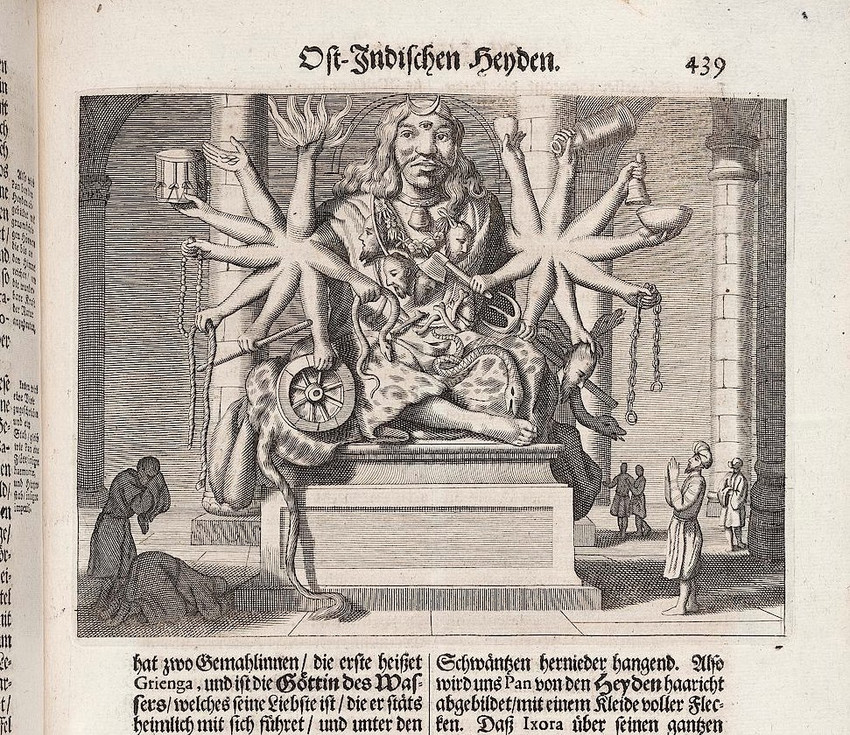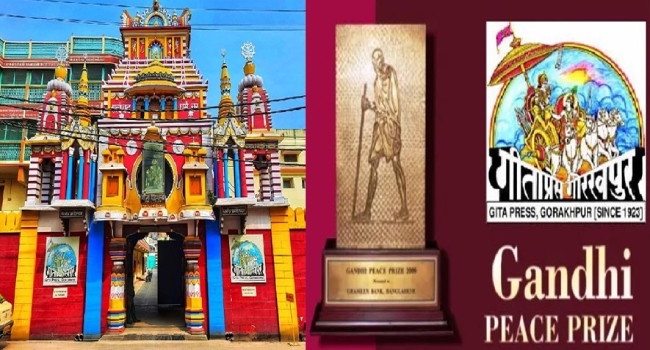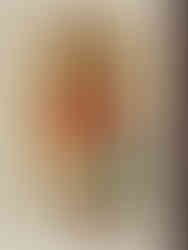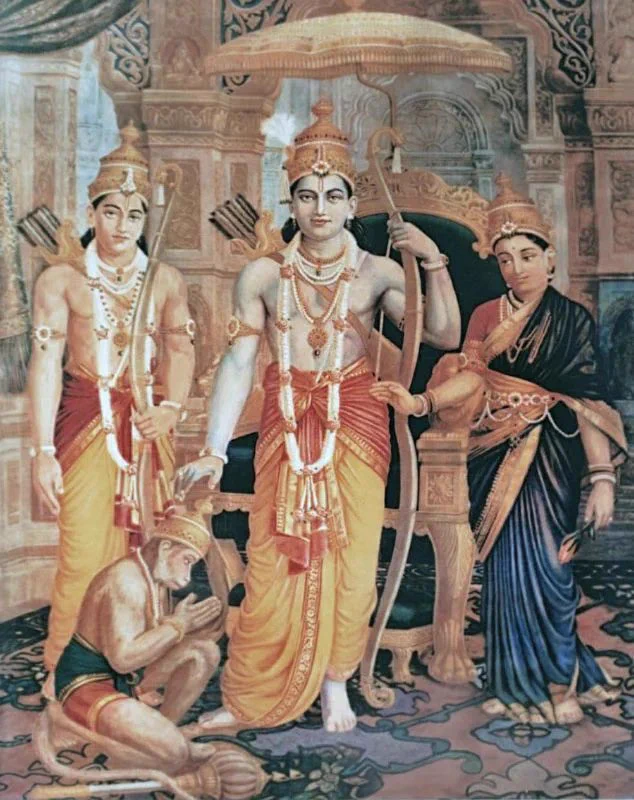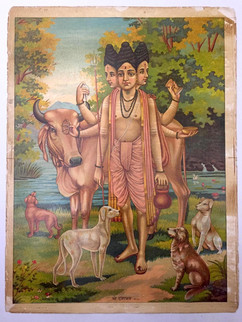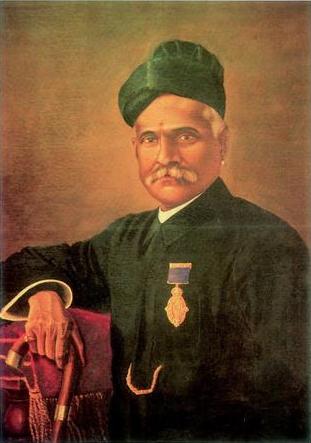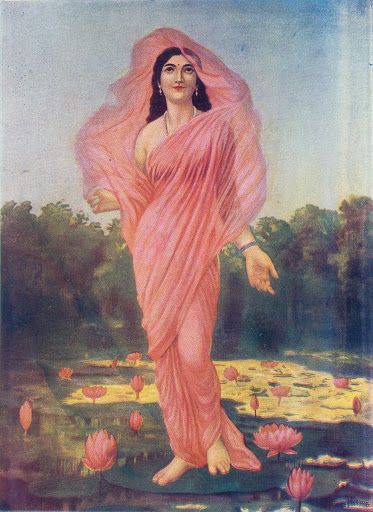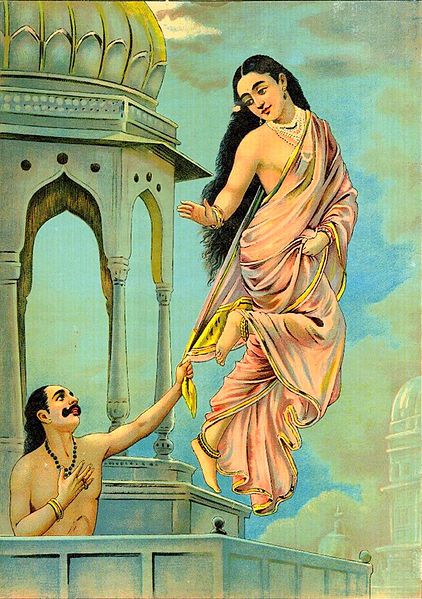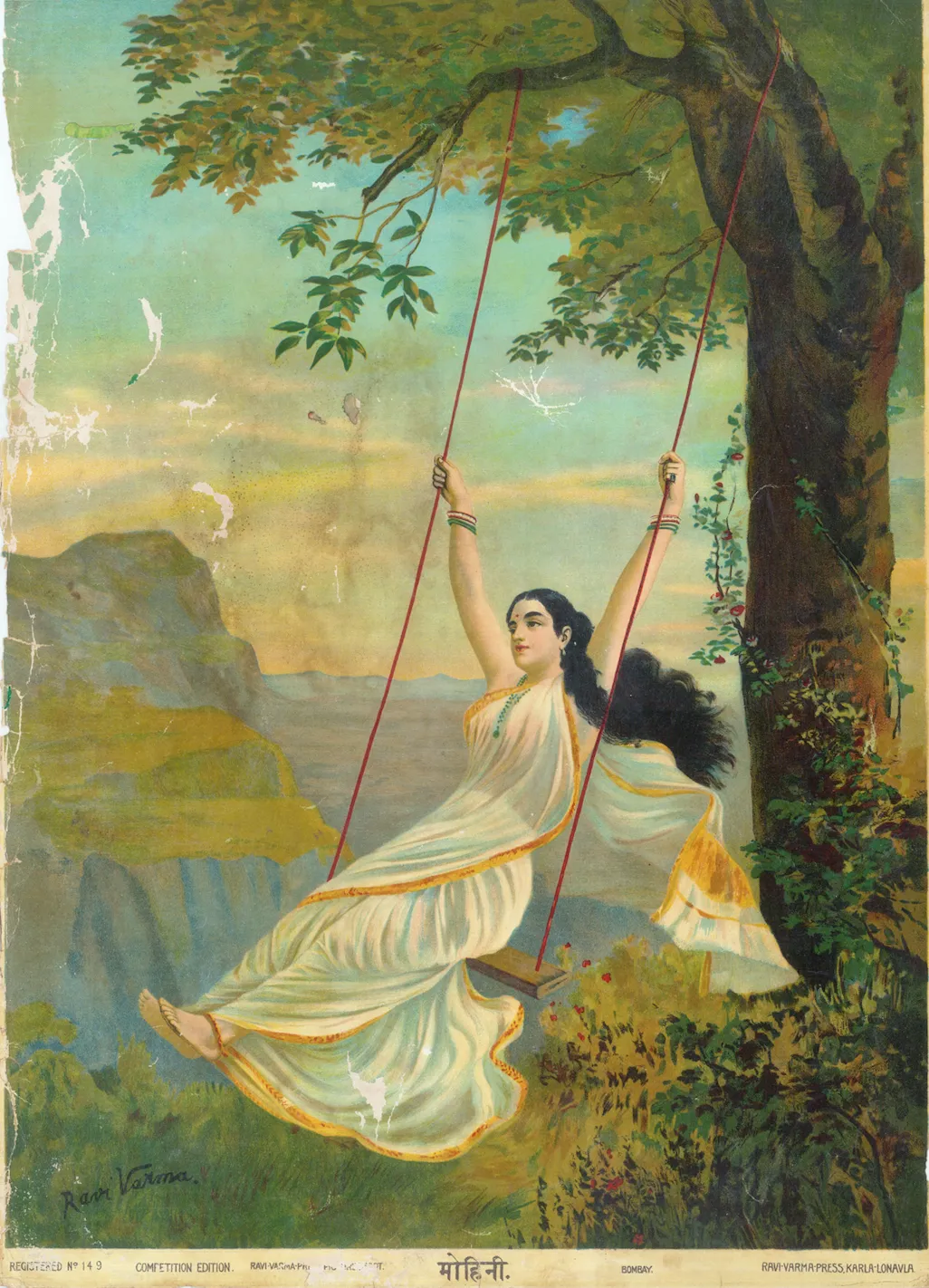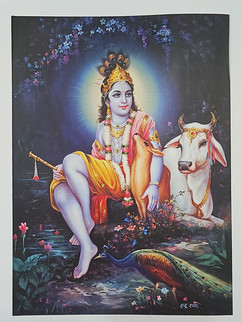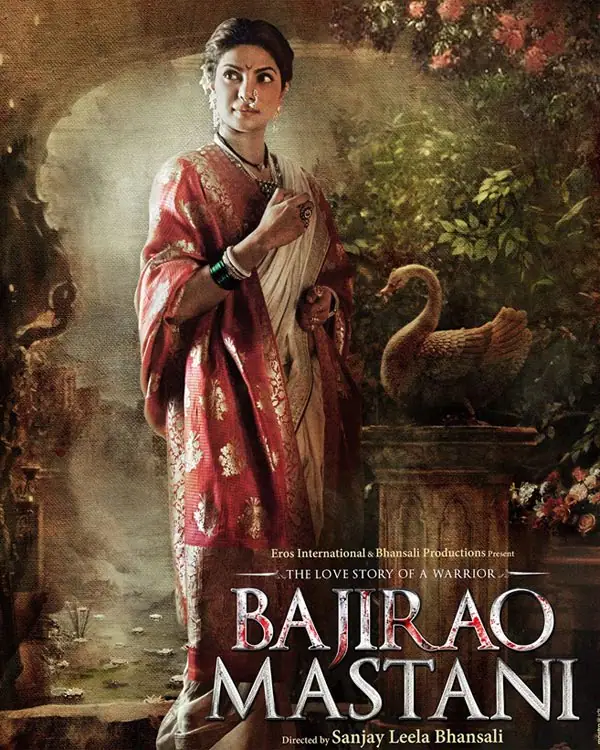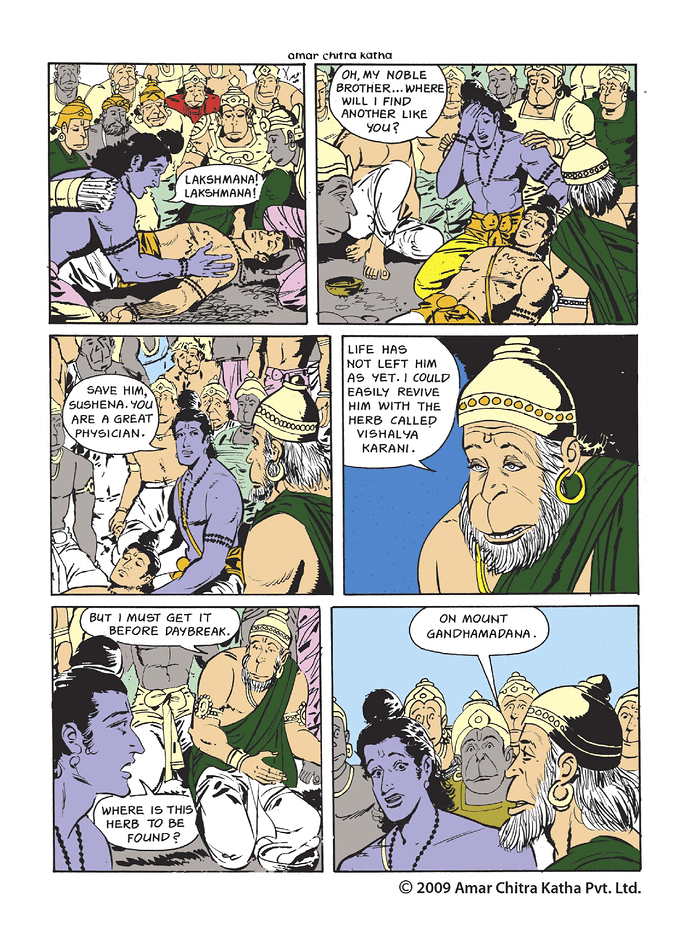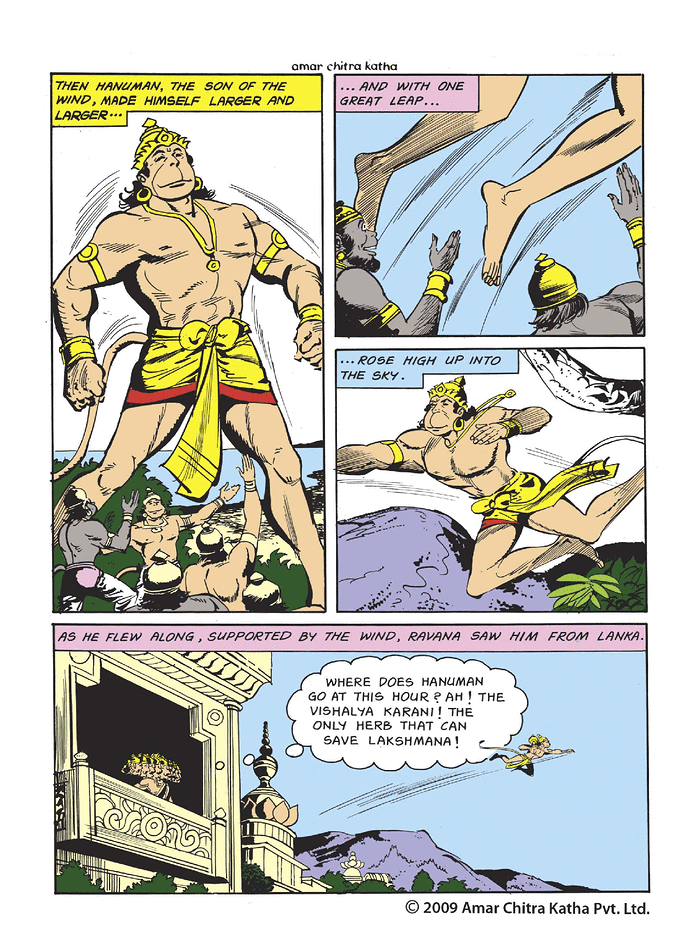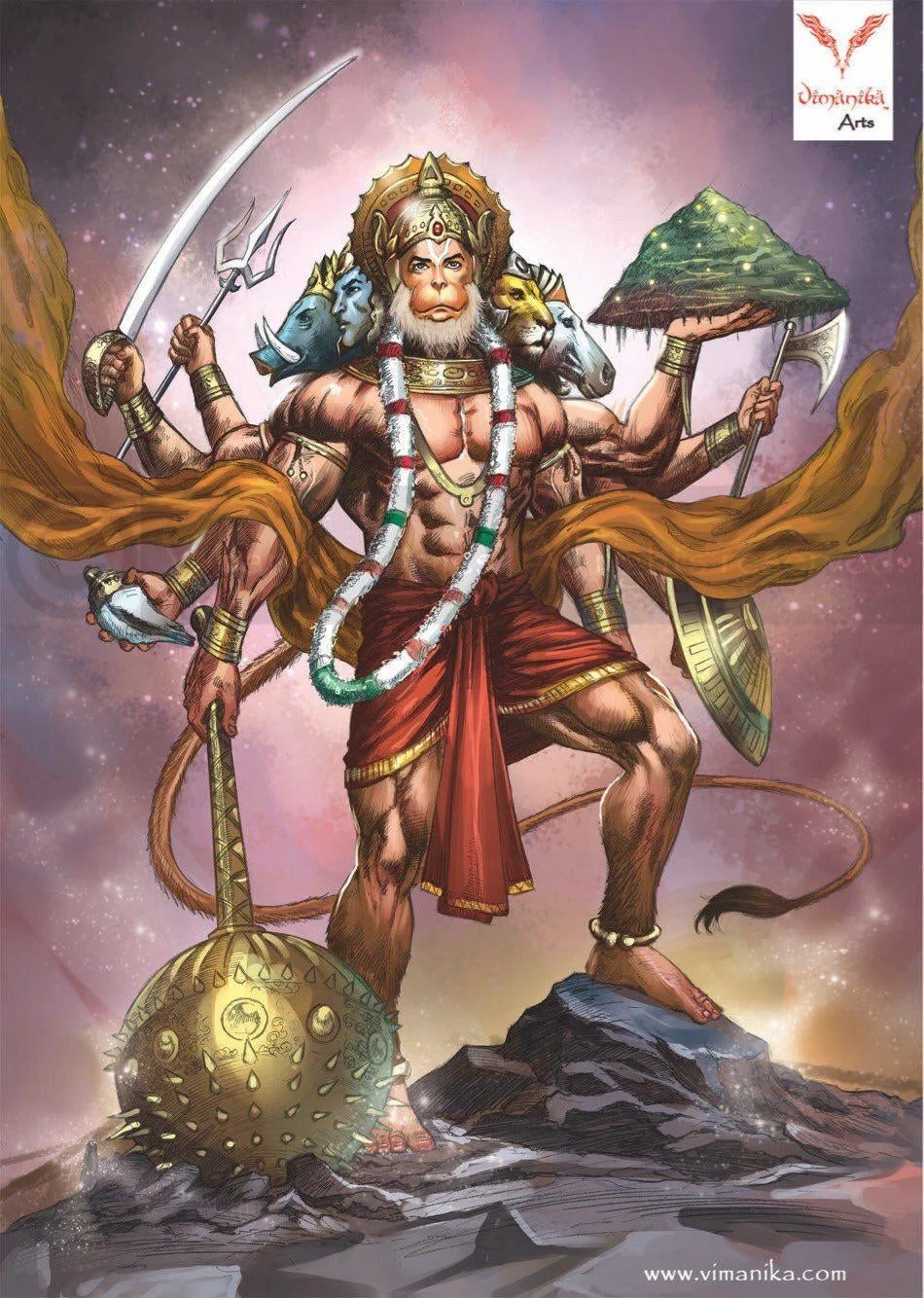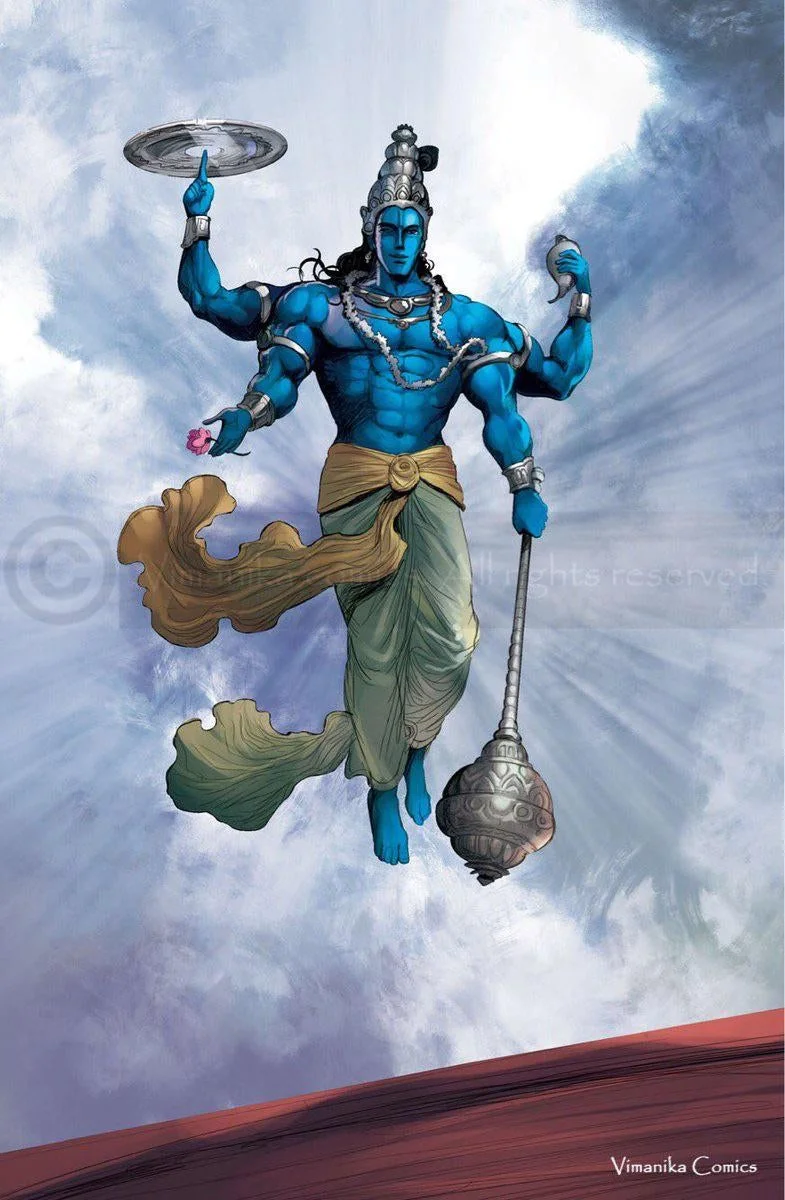
TLDR;
This article explores 'God Photos', their history, cultural impact, and delves into the world of lithography in India. We acknowledge the prominent artists, printing presses and learn about the collection of Mark Baron and Elise Boisanté. We also explore the ideological and sociological significance of these god-prints as the first unifying visual medium in India, contributing to the formation of a new nationalist Hindu imagery. Many VedicFutura 3D Models are inspired by 'God Photos'
Introduction
In the vast tapestry of Indian culture, 'God photos' have emerged as iconic symbols of devotion and spirituality. In India, these lithographs are considered to be true representations of the deities and are widely revered by worshippers. They serve as icons that facilitate a direct and portable connection to the divine. From their rise during the colonial era to their enduring influence in contemporary society, God photos have played a significant role in shaping Hindu culture and devotion.
What is a 'God Photo'?
A God photo is a lithographic print depicting Hindu gods, goddesses, and religious figures. It is important to note that the term "god photo" is a colloquial expression often used to refer to these printed images, while the traditional term for such depictions is "murti" or "vigraha," which are three-dimensional statues or idols of deities.

European Interest in Hindu Iconography
Representations of Hindu iconography took off as Orientalism gripped Europe in the 17th and 18th Century. A movement characterised by the fascination and study of the cultures, religions, and art of the East, particularly India, by European scholars, artists, and intellectuals. Enlightenment thinkers in Europe were interested in comparative religion and the study of different cultures. Art became an important conduit for their cultural exploration.

Antique Steel Engraving Published 1858-60 by Fullarton & Co, London & Edinburgh for "The Faith's of the World..." By the Rev. James Gardner. The plates are after Picart, Roberts, Stanfield and others. (Source: albion prints)
Some of the early forms of mass media were paintings created by local European artists painting Indian scenes.They were based on second hand traveller accounts and sketches. This approach produced some less than accurate and peculiar art but satisfied the curiosity of the general public.
Avatars of Vishnu as imagined and engraved by European artist Bernard Picard c.1721-1722 representing on the left the Varaha or boar avatar and Narasimha on the right, representing the man-lion avatar. Technique:Copper etching Passepartout (Source: invaluable.com)
It's important to note that European interest in Hindu iconography was often selective and filtered through a Eurocentric lens. While it contributed to a broader understanding of Indian culture and religion in Europe, it also sometimes led to misinterpretations and stereotypical representations of Hinduism.
Top: "The Indian God Ixora with 3 eyes and Sixteen Hands", c.1780 by Edward Rooker, a representation of God Shiva (Source: meisterdrucke.ie)
Bottom: A depiction of Ganesha... from the book:"Truthful detailed description of the famous East India Coast Malabar and Coromandel, and the island of Ceylon. By Philippus Baldaeus" Published by John Janssonius of Waesberge and Someren in Amsterdam - 1672 (Source: Rare Book Society of India)
European travellers and explorers who journeyed to India often documented their experiences and observations in travel accounts. The accounts included descriptions, paintings & illustrations of Hindu temples, sculptures, and religious rituals. These paintings and illustrations became a source of fascination for the European elite.
Left: 'Women Of Sivawara Preparing The Sacred Bull Nandi At Tanjore' by Valentine Cameron Prinsep - Orientalist Painting Of India c.mid 1800s (Source: tallengestore)
Right: 'Bathing in the Ganges' by Valentine Cameron Prinsep - Orientalist Painting Of India c.mid 1800s depicting women bathing on the ghats of Varanasi (Source: fineartamerica)
During the British colonial rule in India (1857-1945), there was a growing interest in Indian culture and religion among Europeans. This led to a demand for religious prints and images, both for scholarly study and as souvenirs.

'Temple Of Juggernaut, Engraving, A. G. Vickers. T. Barber. C. 1845' - A Steel engraving print of Shri Jagannath Temple, Puri, Odisha, India (Source: wikisource)
Several European and other painters toured across India during the British Raj, making drawings and paintings. When they returned to Europe, they made prints of their paintings to be published as books or in journals.
Left to Right: 'Kailasa Temple At Ellora' - Yoshida Hiroshi - Japanese Ukiyo-E Woodblock Print; (Source: tallengestore); 'Meenakshi Temple', Madurai - Charles W Bartlett - Vintage 1916 Orientalist Woodblock India Print (Source: tallengestore); 'Great Temple in Madura' - 1931,Yoshida Hiroshi, Showa era Woodblock print; ink and colour on paper Copyright © Smithsonian Institution (Source: Rare Book Society of India)
Picture printing technology gradually evolved from wood block prints to metal etching and eventually to lithography. This progression made art more and more accessible.

'The Great Pagoda, Tanjore', Thomas Daniell c.1798 - A metal engraving print. The initial sketch and proportions were highly accurate due to the use of a camera obscura (Source: meisterdrucke)
The introduction of lithographic printing technology in India during the mid-nineteenth century revolutionised the popular print market. Indian artisans and entrepreneurs seized this opportunity and began producing lithographic prints of Hindu deities to cater to the increasing demand. These prints quickly gained popularity, among European collectors and also among the Indian populace.
From Left to Right: Sculptor Kate Denton printing her lithograph of chickens on lithographic stone; Lithography colour layers to composite print, Illustration from Brockhaus and Efron Encyclopedic Dictionary (1890-1907) (Source: iddk.ru)
What is Lithography?
Lithographs are produced using various techniques, including hand-painting on multiple stones and chromolithography. The prints featured deeply saturated colours, intricate detailing, and stippling techniques that created an optical buzz. Lithography is a printing technique that involves using a lithographic stone or metal plate as the printing surface. A team of artists create the design on a series of stones (later plates), each dedicated to a different colour and portion of the image. These hues were then printed one after the other such that they visually merged. They applied a greasy substance, such as a mixture of gum arabic and lampblack, to create the desired image on the plate. The plate is then dampened and inked, with the ink adhering only to the greasy areas. Finally, a sheet of paper is pressed onto the plate, transferring the inked image onto the paper.
Top to Bottom: Manual Printing Press from c.1933 Madras India with God Photo Lithographs hanging on the wall behind; c.1895, India (Source: indianexpress), Chromolithographic print on paper of Chaitanya Mahaprabhu (source: Met Museum)


Growth of Lithography
Lithography, along with oleography, allowed for the mass production of mechanically reproduced prints of Hindu gods and goddesses. While printing presses existed for centuries before lithography, the advent of chromolithography or colour lithographs was the groundbreaking innovation. It allowed for the creation of finely detailed colour prints with a glossy finish. The effect was striking to ones who saw a lithograph for the first time in 19th and early 20th century. A feeling akin to watching a 4k telecast or 3D movie today for the first time. The accessibility and affordability of lithography contributed to its widespread adoption and the subsequent decline of traditional painting styles in India.
These printed images provided a means of experiencing and engaging with religious and mythological imagery. The walls of households were transformed into vibrant galleries, showcasing the divine figures and narratives that held immense cultural and spiritual significance. The lithographs provided a tangible connection to the divine, allowing devotees to establish a personal relationship with their chosen deities.

Democratisation & Unity
God Photos contributed to the preservation and dissemination of cultural and spiritual values throughout the country. They played a crucial role in democratising religious & nationalist imagery. Previously, access to elaborate temple sculptures or paintings was limited to a privileged few. However, God photos made the divine accessible to all, transcending barriers of class and caste. This democratisation fostered a sense of inclusivity and unity among devotees, reinforcing the idea that divinity resides in every individual. Prior to the advent of lithography, the production of religious prints was primarily limited to handmade woodblock prints, which were time-consuming and expensive to produce. Often accessible only to the affluent sections of society. However, with the introduction of lithography, the process of printing became more efficient and cost-effective.
Left to Right: The Splendour That is India Vintage Print: Published by Associated Printers, Madras,printed in 1930's - 40's; Vintage Lithograph of Goddess Durga with Freedom Fighter Shivaji; Neta Ji Subhash Chandra Bose overlaid on a map of British India, 1930s. (Source: chitravali.com)
Hindu Nationalist Ideals as Print Capitalism
One can argue that the idea of India as a country began to form as lithographic techniques evolved in British Raj. These lithographs became a medium through which the common man could engage with and participate in the rich religious and artistic traditions of India. They contributed to the preservation and dissemination of cultural and spiritual values throughout the country.
Benedict Anderson's concept of "Print Capitalism" provides valuable insights into the role of print media in the emergence of Hindu nationalism in India. "Print Capitalism," suggests that the rise of nationalism in Western Europe was facilitated by mass print media, such as newspapers and journals, that allowed people from different regions to imagine themselves as part of a united community. Anderson refers to these communities as "imagined" because individuals may not personally know or interact with most members of their nation but still hold a sense of belonging through the consumption of printed media. In the case of Hindu nationalism, the emergence of mass print media, played a significant role in disseminating and promoting nationalist ideologies.
Travelling Salesmen selling trinkets and God Photos, typically found near temples and village markets (Copyright Neeraj Charurvedi,Balaji Srinivasan | Dreamstime.com )
Iconic Gita Press and its Travelling Salesmen
While advances in printing technology made lithographs possible, a novel method was needed to reach India's huge population. The Gita Press, for eg. an early, influential Indian publishing house adopted a unique distribution model. They employed a network of traveling salesmen, distributing books to remote villages, towns, and cities throughout India. This ensured that even people in remote areas had access to religious lithographs. This wide distribution enabled individuals from diverse social and cultural backgrounds to imagine themselves as part of a unified Hindu community or imagined nation.
Prime Minister of India, Narendra Modi visiting the viewing gallery at Gita Press (click the arrow to see more)(Source:newindianexpress;theprint)
The Gita Press was awarded the Gandhi Peace Price for 2021 by the Government of India for its role in preservation and dissemination of Hindu religious teachings. Describing Gita Press as a “spiritual light” Modi said the institution was not just associated with “dharma” and “karma” but also carried a national character. “It unites the country and strengthens its unity,”
Left to Right: Four-armed Ganesh, seated, his rat beneath the stool. c.1855. Watercolour. The attributes are outlined but unpainted, (Source: amazon); Durga, mounted on a lion. Digitised Kalighat painting from 19th century Calcutta, created as inexpensive souvenirs for Hindu pilgrims visiting the famous temple of Kali; India, Kalighat painting, c.1875 (Source: The Bodleian Libraries, Oxford) - Two Aspects of Kali- Enshrined - 1980.216.b -(Source: Cleveland Museum of Art)
Origins & Evolution
One notable style that influenced lithographic art was the Kalighat paintings, which originated in the vicinity of the Kali Temple in Kolkata (formerly Calcutta). These paintings depicted mythological themes and everyday life, often with bold lines and vibrant colours, and played a significant role in shaping the visual language of the "God Photos." These were primarily wood block prints and were expensive to produce and needed skilled artists.
Left to Right: Moses destroying the Tables of the Law (colour lithograph)(Source: meisterdrucke); Lakshmi enthroned on lotus, with a radiate solar halo, bundle of wheat and toga-like sari attesting to the strong connection between this print and European depictions of Greek gods. c.1880 (Source:Met Museum); Traditional Saraswathi Tanjore Painting from South India (Source: ethnictanjorearts.com)
The early print lithographs were influenced by European lithographic art and South Indian traditions, particularly Dravidian and Thanjavore art. They depicted gods with unfit bodies, simple hairs, long beards, and moustaches. The outfits of the gods often featured long crowns resembling the Shikhar of Dravidian temples, and the representation of gods with garlands of flowers and heavy jewels reflected the South Indian tradition. The landscapes depicted in the lithographic images included royal courts, mountains, flowers, rivers, gardens, birds, animals, temples, shrines, and other holy symbols associated with the gods.
Top Left and Right: Two versions of the Coronation of King Rama- Sri Ram Pattabhishekam Raja Ravi Varma c.1930, (source: Google Arts And Culture); 'Kothanda Rama' by G.V. Venkatesh Rao, Ravi Varma Press (source: indianexpress)
Bottom Left and Right: Versions of Hanuman carrying Rama and Lakshmana to Battle: "Maruti Skandharudh Rama Laxmana" by the Ravi Varma Press, 1910's (source: wikimedia), Hanuman Carries The Brothers, J. B. Khanna & Co..Vintage print, circa 1970's. (source: etsy)
Only in the 1940s and 1960s, muscularity and warrior looks began to emerge, replacing the earlier depictions. This evolution was due to its role in the nationalist movement and the spread of political ideas. Artists and activists utilised lithography to create posters, pamphlets, and other printed materials that conveyed messages of independence, social reform, and national pride.
Early Iconic Printing Presses
Several printing presses and studios played pivotal roles in the creation and dissemination of God photos. Initially, Indian publishers sent original artwork to Europe to be reproduced. However, by 1878, the first chromolithography shops were established in India, leading to a flourishing industry of popular sacred imagery.
Left to Right: Rama, Sita, and Lakshmana in Exile: Scene from the Ramayana probably Germany for the Indian market Undated, ca. 1880–1900 Met Museum; Oleograph print from 1920s- 1930s of Vanvasi Ram by Ravi Varma Press Lonavla, Ravi Varma Foundation, (source: wikimedia)
European Influences: 19th Century
The latter half of the 19th century witnessed the rise of German chromolithography, which revolutionised coluor printmaking worldwide. In India, the impact of European presses was palpable. German prints depicting European landscapes and beauties, which flooded the Indian market, influenced local artists and served as a catalyst for the Indian god-print industry. The affordability and quality of these European prints challenged indigenous producers, sparking a wave of competition and innovation.
European printers recognized the potential market for inexpensive prints of Hindu subjects and offered them at lower prices, using cheaper materials and faster machinery. While these prints retained the primary iconographic features of the deities, the resulting designs often showcased a fusion of Indian and European elements, creating intriguing and sometimes enigmatic artworks.
Selection of Prints from the Calcutta School of Art, late 1800s to mid 1900s
Top Left To Right: Vishnu rests on the serpent Ananta while Brahma appears within a lotus flower emitting from Vishnu's navel c.1895 (source:British Museum); 'Bijaya'-West Bengal, Calcutta 1878–1883 (source:Met Museum)
Middle Left To Right: Śiva stands in front of Parvati in an ornately decorated pillared hall,Chore Bagan Art Studio c.1895 (source: British Museum), Shiva Mahadev, West Bengal, Calcutta,1878–1883 (source:Met Museum); Matsya Avatar, Print from the repository of Victoria Memorial, Kolkata. Lithograph on paper published by Calcutta Art Studio c.1885-1900
Bottom Left To Right: A goddess probably Parvati as Durga riding on a lion presenting an infant Ganesha to her mother Menaka. Chromolithograph. (source: wellcomecollection.org); Narasimha Avatar of Vishnu,Print from the repository of Victoria Memorial, Kolkata. Lithograph on paper published by Calcutta Art Studio c.1885-1900; An episode from the Mahabharata, Nala and Damayantῑ are in the forest. Damayantῑ is shown asleep on the ground beneath a tree while Nala is sitting beside her, holding her hand. c.1895 (source: British Museum)
Calcutta's Flourishing Presses: 19th Century:
The emergence of the Calcutta School of Art in 1878, and the increasing popularity of oil painting and a realistic, illusionist style had a significant impact on the art scene in India. The artists and intellectuals associated with the Calcutta School of Art embraced the Western artistic conventions, which emphasized three-dimensional naturalism and a tactile quality in artwork. This shift towards Western aesthetics created a demand for a new medium that could effectively capture and reproduce these visual qualities, and lithography fulfilled that requirement. Led by Ananda Prasad Bagchi and his students from the Government School of Art, the studio marked the beginning of an era. Soon, other smaller firms and individual artists joined the religious print market, reflecting Bengali religious culture through their selection of deities and regional iconographies.
Selection of Lithographs from Chitrapriyaprakash Press & Chitrashala Press, late 1800s
Top Left to Right: "Shri Mahavira Swami," bazaar art, c.1910's-1920's (Source: wikimedia.org); Goddess Sarasvati, India,ca. 1890–20 (Source: Met Museum); Gajendra Moksha Chitrashala Press, Poona. 1910's (Source: ebay)
Middle Left to Right: Shri Dattatreya,c.1880s (Source: theindianportrait); Coronation of King Rama c.1910, Ravi Varma Press (Source: wikimedia.org); Panchmukhi Maruti, No. 714 Ravi Varma Press, Malavali, G.I.P., printed in India (Source: christies.com)
Bottom Left to Right: Ganpati Parvati (Source: art365.in); Shiva Parvati (Source: art365.in); Gayatri c.1900 (Source: omfromindia.com)
Maharashtra's Robust Style: Late 19th Century:
Simultaneously, in western India, presses like the Chitrapriyaprakash Press in Bombay (Mumbai) and the Chitrashala Press in Poona (Pune) cultivated a distinctive and robust style of god-prints. While little is known about Chitrapriyaprakash, the Chitrashala Press, founded in 1878 by Vishnu Krishna Chiplunkar, played a pivotal role in the artistic and political landscape. Chiplunkar's vision encompassed not only the publication of religious prints but also the broader agenda of cultural and political mobilization through art. These Maharashtrian presses, through their intriguing compositions and intense color palettes, left an indelible mark on the evolving genre.
Left to Right: Ravi Varma Self Portrait (Photo Source: Rupika Chawla); Goddess Saraswati, Goddess of knowledge. This print from the Ravi Varma Press derived from a painting by Raja Ravi Varma follows the iconographic description of Saraswati as found in the 50th chapter of the Agni Purana. (Source: Google Arts and Culture)
The Reign of Ravi Varma: Late 19th to Early 20th Century:
Amidst this artistic renaissance, Raja Ravi Varma, often hailed as the "father of Indian calendar art," etched his name in the annals of religious printmaking. His paintings exemplify the fusion of European academic art with a distinct Indian sensibility and iconography. He is often referred to as the first modern Indian artist for his contributions to the art world.
His legacy is marked by his ability to reconcile Western aesthetics with Indian iconography, creating a unique artistic style that resonated with both Indian and international audiences. Varma's artistic contributions extended beyond his paintings. In 1894, Ravi Varma established the Ravi Varma Fine Art Lithographic Press near Bombay. Collaborating with German technicians and inspired by both Indian and European artistic traditions, Ravi Varma created an extensive repertoire of prints that were affordable and accessible to the Indian public. This innovation greatly contributed to the popularization of art in India, expanding its reach and influence.
Selection of Lithographs from Ravi Varma Press showing evolving styles and treatment of themes
Top Left to Right: Kali trampling Shiva, c.1910 (Source: Google Arts and Culture); Lord Shiva and Parvati sitting in a throne Oleograph of Ravi Varma. 1928. (ECP 144) (via ebay: havan21); Shri Hanuman,c.1910-20 (Source: art365.in)
Middle Left to Right: Sree Raghunandan - Ram Laxman Sita And Hanuman, Raja Ravi Varma Press (Source: archerindia.com); Viraat Swaroop - Raja Ravi Varma Press Oleograph Print 1910s (Source: wikimedia.org); Vastra Haran by Krishna (Source: wellcomecollection.org)
Bottom Left to Right: Vishnu appears before Dhruva – Raja Ravi Varma (Source: wikipedia); Ravi Varma Press, Karla - Lonavla 1920s (Source: chitravali); Matsya Avatar of Vishnu, Pre 1945, Printed by Ravi Varma Press (Source: oldindianarts.in)
Varma's paintings encompassed a wide range of themes, with a particular focus on religious depictions of Hindu deities, scenes from Indian epics such as the Mahabharata and the Ramayana, and portrayals of Indian women, whom he considered beautiful.
Raja Ravi Varma's portrayal of women often emphasised their physical beauty and grace, setting a new standard for beauty in Indian art.
Top Left to Right: Woman Holding a Fruit (19th century) (Source: wikimedia.org); Padmini c.1890 (Source: Google Arts & Culture);
Bottom Left to Right: Urvashi and Pururavas c.1890 (Source: wikimedia.org); “Mohini” or “Mohini on a Swing”, 41 x 59 cm, oleograph; Hindu goddess, the only female avatar of Vishnu, meaning enchantress, is depicted on a swing with open hair and a sheer white saare, bare arms depicting carefree and seductive nature. (Source: architecturaldigest)
His works continue to be revered for their artistic prowess, although his legacy remains somewhat controversial, with debates surrounding the perceived showiness and sentimentality of his style. Nonetheless, the Ravi Varma Press paved the way for future generations to reimagine the portrayal of Hindu deities.
New Horizons: Early 20th Century:
As India ventured into the early 20th century, new presses emerged outside the realms of Calcutta and Maharashtra. Delhi-based Hemchander Bhargava,
Selection of Lithographs from the studio of Hemchander Bhargava
Top Left to Right: Shree Shankar, offset-lithograph, c. 1935-1940. (Source: omfromindia); Durga 5 Bells Publisher: Hem Chander Bhargava & Co., Delhi. circa 1970s. (via Etsy: EasternImage); Lord Krishna, as Dark Krishna the enemy of Mara, 1930s (Source: etsy)
Middle Left to Right: Kaaliya Mardan Artist: Indra Sharma. Publisher: Hem Chander Bhargava & Co., Delhi. 1940s (via eBay: Vintagebooksindia); Rama & Lakshmana c.1910-15 (Source: etsy); Lord Vishnu Circa 1960. Published by Hem Chander Bhargava & Co., Delhi. (via Etsy: EasternImage)
Bottom Left to Right: Shri Gangaji, lithograph, c. 1910-1920, Hemchander Bhargava (Source: omfromindia); Ashta Laxmi Publisher: Hem Chandar Bhargava & Co., Delhi (via eBay: allegory003); Anjani Kumar (Boy Hanuman) c.1910-15 (Source: omfromindia)
with its focus on niche markets and diversifying religious prints, played a pivotal role in expanding the genre. In Rajasthan, Harnarayan & Sons rose to prominence by catering to a regional audience's interests.
Selection of Lithographs from the studio of Harnarayan & Sons
Left to Right: Radha Krishna, Harnarayan & Sons, Bombay. (via Etsy: LoveFromLakshmi); Manohar Gopal Krishna, Harnarayan & Sons, Bombay. (via eBay: Julieeshop); Man-Har Krishna by Narottam Narayan Sharma, c. 1930's, Harnarayan & Sons, Jodhpur (Source: omfromindia); Krishna Mohini,c. 1950, Artist: B.G. Sharma (via ebay: havan21)
These presses, along with the iconic S. S. Brijbasi and Sons, founded in 1922, ushered in an era of innovation and experimentation, connecting with artists from Nathadwara and redefining the popular representation of Hindu gods.
Selection of Lithographs from S. S. Brijbasi and Sons
Top Left to Right:‘Lord Shiva - Theen Moorthy’ Publisher: S. S. Brijbasi & Sons, Bombay. Artist: Rangroop. (via Source: Oleograph Lithograph INDIA); Shri Yamuna Ji, Publisher: S. S. Brijbasi & Sons, Bombay. (via eBay: Allegory003); The artist Narottam Narayan Sharma depicts the flute-playing child-Krishna in an enchanted moonlit landscape. Originally printed in Germany on state-of-the-art chromo-lithographic presses in the mid-1930s, on artwork supplied by the Indian publisher S. Bribasi & Sons, of Karachi & Muttra (Source: fineartamerica)
Bottom Left to Right: Shiva Panchayatan, Lakshmilall (of Nathdwara) c.1952,Lord Shiva’s assemblies are most often out-of-doors, in the Himalayas, but here Lakshmilal has brought them indoors, in the style of Lord Rama’s panchayatan,S. Bribasi & Sons, of Karachi & Muttra (Source: Google Arts and Culture); Gopala Krishna Krishna (Source: krishnastore); A 1935 poster print of Lord Krishna's Vishwarupa by Brijbasi and Sons. (Source: reddit)
Post-Independence Pioneers: Mid-20th Century:
With the dawn of India's independence in 1947, religious prints experienced unprecedented growth, reaching wider audiences and assuming commercial roles in advertisements and calendars.
Selection of Mid Century Lithographs by B.G.Sharma
Left to Right: Sampooran Virat Swaroop, Oleograph by Sharma Picture Publication signed by B.G.Sharma (Source: storyltd); Hanuman in Worship, Publisher: Sharma Picture Publication. Circa 1970s. (via Etsy: EasternImage); 'Dashmukhi Mahakalika'-The Ten Headed Great Kali (Source: etsy)
Artists like Indra Sharma and B. G. Sharma, hailing from the Nathadwara tradition, emerged as influential figures during this period. Their vibrant and direct styles, incorporating elements from Indian folk arts and mythology, propelled religious prints to new heights of popularity.
Left to Right: Shri Lakshmi Devi, Sarasvati Devi & Ganesh, c.1990s, Indra Sharma (Source: etsy); Gopala Krishna - The Cow Herd Prince c.1990s, (Source: iskconeducationalservices); Rakhal Raja Krishna, c.1990s, Indra Sharma (Source: dollsofindia); Hanuman Burns Lanka, c.1990s, Indra Sharma (Source: flickr)
Other notable artists and printing presses include K.G. Menon, K.C. Sen, The Ravi Varma Press, The Shalimar Art Company, and The Ravi Varma Fine Art Lithographic Press. These establishments contributed to the proliferation of God photos, ensuring their availability across different regions of India.
Influencing Popular Culture
Various Depictions of Vishnu's Vishwarupa or Universal Form in Popular Culture
Left to Right: Screengrab from Ramanand Sagar's 'Ramayan' (1987), an epic TV series with a recorded viewership of 82% of India, depicting the Vishwarupa or Universal form of Vishnu (Source: youtube); Lithograph depicting the Vishwarupa form of Vishnu by C.Kondiah Raju, T.S.Subbiah (Source: thevarartgallery); Bras Statue of the Vishwarupa inspired by the lithograph (Source: etsy); Graphic T-Shirt depicting the Vishwarupa (Source: redbubble)
The stylised representations influenced not only the perception of divinity but also influenced the wider artistic expressions of the common man. The bold and vibrant colours, intricate detailing, and iconic poses of the gods and goddesses depicted in these prints became ingrained in the popular visual culture to this day. The motifs and symbols from these prints became inspiration for local artisans and craftsmen, who incorporated them into their creations, such as textiles, pottery, and jewellery.
God Photos are a major source of inspiration to Indian Artisans
Left to Right: Goddess Sri Lakshmi, R U & V Press Ghatkopar Bombay (via ebay: allegory003); Banarasi Silk Saree with Traditional Motiffs (Source: zaribanaras); Jagadhatri Form of Durga, Calcutta Art Studio 185 Bowbazar Street Calcutta.”. Printed and published around 1885. (Source: Calcutta Art Studio)
By providing an affordable means of acquiring and experiencing religious imagery, these prints influenced the aesthetics of the common man. The prints fostered a collective familiarity with the pantheon of Hindu gods and goddesses, regardless of regional or linguistic differences. It created a common visual language that transcended social and cultural boundaries.
In the early 1900s, prints featuring Indian gods and mythological figures began to make their way into advertisements, reflecting a unique fusion of spirituality and consumerism.
Top Left to Right: Lithograph calendar advertising Woodwards Gripe Water for children,c.1947 (Source: chitravali); Vinolia Soap advertisement featuring Ravi Varma's painting of Saraswati. Originally painted in 1890 but used commercially early 1900s (Source: Art Historian via Twitter); Lithograph calendar featuring boy Krishna dancing on the snake Kalia, advert for 'Burmah-Shell' Oil Company c.1939 (Source: Chitravali)
Middle Left to Right: Lithograph calander for Godrej toilet soaps (Chavi brand) featuring an image of Vishnu c.1939 (Source: oldindianads via Twitter); Lithograph calendar advertising Sunlight Soap featuring an image of Krishna as the divine cowherd, c.1932 (Source: chitravali); This image of Kali c.1885-95, the ferocious slayer of demons, appeared in various versions till as late as the 1920s. This particular image attained iconic status in part because of its wide distribution and use to advertise cigarettes. Part of the text below the deity is as follows:
"If you care to improve the manufacture of national products, if the welfare of the nation’s poor laborers is your concern, if you have a sense of good and bad, then O Hindu brothers, smoke these Kali cigarettes. (Translated by C. Pinney)" (Source: metmuseum)
Bottom Left to Right: Lithograph ad for Hashish featuring Vishnu, Naradha and Garuda c.1970, printed when Hashish was legal in Nepal (Source: authenticvintageposters); An Ad for Valet Auto-Strop Safety Razor, From Times of India Annual,c.1930. Artwork by W S Bagdatopulos, featuring Subramanya astride his mount Peacock. (Source: 8ate); Lithograph ad featuring a unique rendition of Santana Lakshmi c.1920s (Source: oldindianarts)
'God Pictures' In Media & Advertising
These prints also became a medium for the advertisement of goods and services. Examples include the depiction of goddess Saraswati in an advertisement for Kuntalbrisha Oil and the image of goddess Kali in an advertisement for "Kali Cigarette." Woodwards, a firm that created colic relief water, famously featured imagery of baby Krishna gloriously dancing on the hood of the defeated Kalia as a metaphor for babies conquering colic and emerging victorious. In 1927, the Vinolia soap company used a painting of Saraswati by Ravi Varma for their advertising campaign. These commercial god-prints reflected the social movements of the time, such as the Swadeshi movement, which promoted the use of indigenous products to support native laborers and industries. As Hindu nationalism gained momentum, these prints were also utilized for political propaganda, promoting a sense of pride in Hindu heritage and fostering a collective identity. By the late 1940's the Indian government began to use Varma's paintings on postage stamps. This helped to further popularize Varma's work and to promote Indian culture around the world.
Ravi Varma's aesthetic sensibilities and attention to detail continue to inspire filmmakers, designers, and advertisers in contemporary India
Top Left to Right: Poster for movie 'Bajirao Mastani' (2015) inspired by Raja Ravi Varma painting of 'A Swan Telling Damayanti of Nala's love. Chromolithograph'c. early 1900 (Source: bollywoodlife)
Middle Left to Right: Raja Ravi Varma inspired 'Rang Rasiya'(2008) movie poster, (Source: Rang Rasiya via Twitter); Urvashi and Pururavas c.1890, Raja Ravi Varma (Source: wikimedia.org)
Bottom Left to Right: Costumes in Malayalam movie 'Marakkar: Lion of the Arabian Sea'(2021) inspirired by Raja Ravi Varma paintings (Source: indiaglitz)
Many of Varma's paintings were used as inspiration for film posters and costumes, and his work helped to create a new visual aesthetic for Indian cinema. Varma's paintings also influenced the way in which Indian actresses were portrayed on screen, this helped to challenge traditional stereotypes about Indian women.
Excerpts from comic books from Amar Chitra Katha, an Indian publishing company whose name translates as Immortal Illustrated Stories & Vimanika Comics (Source: amarchitrakatha, vimanikacomics, New York Times)
Comics featuring Indian gods and goddesses have become a rite of passage for today's children, offering a captivating blend of mythological storytelling and vibrant visuals. They play a crucial role in passing down India's rich cultural heritage to the younger generation.
In addition to Varma's influence, the advent of comic books and graphic novels in India had a profound impact on the portrayal of gods and goddesses. Artists began to incorporate dynamic poses, vibrant colors, and bold lines into their prints, reminiscent of comic book aesthetics. This infusion of a more contemporary visual language helped to engage younger audiences and bridge the gap between traditional religious art and modern sensibilities.
God Photo lithograph collectors actively trade on ebay and other auction websites (Source: ebay)
These prints have become an integral part of religious practices, and their historical and artistic value has garnered interest and appreciation from collectors and curators worldwide.
Left to Right: Gods in Print, a book about the lithographic traditions of India (Source:amazon); Mark Baron and Elise Boisante at their home in New York (Source:rangdecor.blogspot.com)
Mark Baron and Elise Boisante, renowned collectors and connoisseurs, have dedicated themselves to amassing one of the world's most comprehensive collections of 19th and early 20th-century Hindu mythological prints. Their collection showcases the evolution of this art form, from woodblock prints to lithographs, and highlights the diversity and beauty of Indian religious iconography. The collection focuses on the first fifty years of Hindu god and goddess prints, starting with mid-19th century woodblock prints from Calcutta. It includes a wide range of 19th-century lithographs, many of which are hand-colored, sourced from early publishers and presses such as Calcutta Art Studio, Hindu Art Studio, Chore Bagan Art Studio, Chitrapriyaprakesh Press in Bombay, and Chitrashala Press in Pune. Their collection is documented in their book 'Gods in Print'. In recent years, with a surge in Indian collectors' interest in the earlier Calcutta prints, the market has witnessed significant changes, and the value of these prints has soared.
Many Vedic Futura 3D models are inspired by the 'God Pictures'. These models have proved to be endearing and popular wherever they are shared. It became essential to gain a comprehensive understanding of their origins, cultural significance, and aesthetic traditions. By studying and understanding their artistic nuances, we strive to preserve their unique charm into the third dimension. We hope our work showcases the timeless relevance and adaptability of these beloved lithographs in the modern era.
Visit our page on Cults3d and MyMiniFactory to check out our complete collection. Free models are on Printables, Thangs & Thingiverse. You can support our work by buying our 3D Models or subscribing to us on Patreon & MMF Tribes. Check out our lithograph 3D prints made with HueForge!






